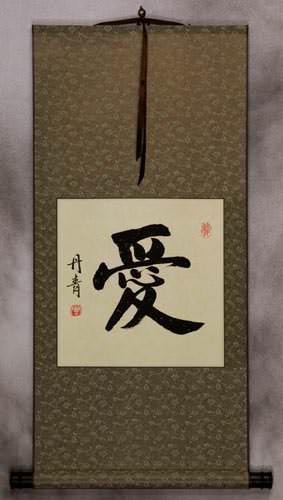LOVE
Chinese and Japanese Kanji Calligraphy Scroll


34¾"
19¾"
Typical Gallery Price: $80.00
$33.88Sold Out
Sorry you missed it.
• Hand-Painted Artwork.
• Handmade Wall Scroll.
• Money-Back Guarantee.
Approximate Measurements
Artwork Panel: 32.1cm x 32.3cm ≈ 12½" x 12¾"
Silk/Brocade: 41.5cm x 88.4cm ≈ 16¼" x 34¾"
Width at Wooden Knobs: 50.5cm ≈ 19¾"
Information about caring for your wall scrollSee Larger Image
The Love Character in Chinese, Japanese Kanji, old Korean Hanja, and old Vietnamese
Before we start...
A quick lesson in Chinese Hanzi, Japanese Kanji & Korean Hanja
Traditional Chinese Characters often referred to as Hanzi in Chinese, Kanji in Japanese and Hanja in Korean (Chinese characters were commonly used in Korea until about 100 years ago).
Japanese Kanji, Chinese Hanzi, and Korean Hanja are almost always visually the same, and usually hold the same meaning.
Sometimes the use of a word can vary by culture...
In the case of "love" you will hear couples say "I love you" quite often in China and Korea.
However, in Japanese culture, a man is more likely to say "I like you" (Watashi wa anata ga suki desu) or if he really means it, "I like you a lot" (Watashi wa anata ga suki desu... ...dai suki desu!)
This leaves "love" as something you are more likely to write about rather than speak if you are Japanese.
So "love" carries the same meaning in all three cultures, it's just used more often in China and Korea.
In an interesting twist regarding this "love symbol", the word for love is pronounced "ai" (like "eye") in all three languages. The pronunciation of love was borrowed from Chinese along with the symbol of love itself.

This is the Chinese character for "Ai" which is "Love".
This may be hard to imagine as a westerner, but the strokes at the top of this love character symbolize the family & marriage.
 The symbol in the middle is a little easier to identify. It is "xin" which is
the character for "heart" in Chinese and Japanese. I guess you can say that no matter if you are from the East or the West, you must put your heart into your love.
The symbol in the middle is a little easier to identify. It is "xin" which is
the character for "heart" in Chinese and Japanese. I guess you can say that no matter if you are from the East or the West, you must put your heart into your love.
 The strokes at the bottom create a modified "you" character which means "friend". (pronounced like "yo" -
to call someone "friend" you'd use two characters and it would sound like "pung-yo" using English pronunciation rules).
The strokes at the bottom create a modified "you" character which means "friend". (pronounced like "yo" -
to call someone "friend" you'd use two characters and it would sound like "pung-yo" using English pronunciation rules).
I suppose you could say that the full meaning of "Ai" is to love your family, spouse, and friends with all of your heart, since all three elements exist in this character.
A simple phrase in Chinese in which this word is used is:
|
|
|
 |
 |
 |
This is pronounced roughly "wha eye knee" using English words/rules of pronunciation.
If you want a quick education on Chinese character history, read below...
Examples of the earliest pictographs or hieroglyphics in China date back almost 5000 years. The area now known as China was a fragmented region with various kingdoms rising and falling. Each kingdom or nationality in China had it's own writing system, and could not effectively communicate with people of other kingdoms.
Finally, in about 221 B.C. the Qin Dynasty unified all of China. One of the Qin Emperor's goals was to standardize the writing system across all of his empire.
The official script was the second-generation of writing approved during the reign of Qin.
This official script was still very complex to write, with the invention of the printing press still thousands of years away, official scribes literally had their hands full as they penned various documents. Historian will argue this point, but the Traditional Chinese Characters that you see today entered a somewhat final lexicon during the Wei kingdom (220-265 A.D.) and the Jin Dynasties (265-420 A.D.)
The adoption of Simplified Chinese Characters happened under Chairman Mao in the early 1950s in an effort to make it easier for under-educated people to learn to write. However, true calligraphers will only write Traditional Chinese Characters. Places like Taiwan, Hong Kong, Singapore, and several other regions in Asia that were unaffected by Chairman Mao's rule still use traditional characters in day to day life.
Traditional Chinese Characters are known in Japanese as Kanji. In Japan, these characters are used every day in newspapers, magazines, documents, and personal letters. However, they are mixed with Japanese-specific characters called Hiragana, which means a Chinese person trying to read a Japanese newspaper can only get the gist of what the story might be about.
In China, people speak all kinds of languages such as Mandarin, Cantonese, Shanghainese, Tibetan and many other regional languages. When two Chinese people meet, they might not be able to understand each other because they speak different Chinese languages. But they can write down what they are trying to say, and be easily understood thanks to the Qin emperor's dream of a standardized writing system.
Think about this fact:
One third of the world's population can understand the Chinese characters shown above, while only 6% of the people in the world can natively understand the English words that I am writing here.
© 2005 OrientalOutpost.com
This item was listed or modified
Oct 18th, 2014
Typical Gallery Price: $80.00
$33.88Sold Out
Sorry you missed it.


